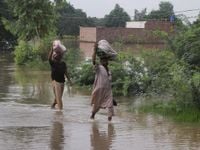Pakistan is once again grappling with the fury of monsoon season, as record-breaking floods sweep through Punjab and threaten to inundate Sindh. The crisis, which has unfolded over the past two weeks, has left millions displaced, crops destroyed, and entire communities scrambling to survive. Authorities warn that the worst may not be over, with more torrential rain forecast and floodwaters expected to surge even higher in the days ahead.
On September 7, 2025, a high-level flood alert was issued in Punjab after India shared information about fresh releases of water into Pakistani rivers, according to The Express Tribune. The alert came as the province was already reeling from previous waves of flooding, with the water now moving south toward Sindh. Disaster management officials cautioned that a new spell of monsoon showers would continue until September 9, compounding the already dire situation.
The three major rivers of Punjab—Ravi, Sutlej, and Chenab—have been especially hard hit, with water levels rising rapidly due to upstream discharges from India. In Gujrat and southern Punjab, the situation was described as critical. In some areas, such as Jalalpur Pirwala, the army was called in to assist with mass evacuations as floodwaters breached embankments and inundated entire settlements. Tragically, on the night of September 7-8, a rescue boat carrying 30 people capsized in Jalalpur Pirwala, resulting in the deaths of a 70-year-old woman and four children. "Financial assistance will be provided to the affected family within 24 hours," said Punjab Relief Commissioner Nabil Javed, as reported by The Express Tribune.
By September 8, 2025, the scale of the disaster had become painfully clear. Punjab Information Minister Azma Bokhari announced that the flood death toll in the province had risen to 60, with at least eight injured. Since late August, heavy monsoon rains and releases from Indian dams have caused water levels in Punjab’s rivers to rise sharply, affecting over 4,335 areas and 4.2 million people. More than 2.147 million people and 1.549 million animals have been relocated to safer locations, but the toll on livestock remains steep, with 1,543 animals reported dead. Agricultural devastation is widespread, as Bokhari noted: "Fields of sugarcane, rice, cotton and vegetables have been affected by the floods," with 1.841 million acres of crops lost.
Rescue operations have been relentless. In Multan, located between the Sutlej and Chenab rivers, floodwaters breached at least three embankments, inundating dozens of villages and submerging homes and farmland. Jalalpur Pirwala, in particular, has been among the worst-hit places, with about 500,000 people trapped by floodwaters as of the morning of September 8. Some residents sought refuge on rooftops, while others clung to trees to escape the rising water. Al Jazeera’s Kamal Hyder reported from Multan: "There aren’t sufficient boats to evacuate these people. Helicopter operations have been called in, but the weather is also not good."
Punjab Chief Minister Maryam Nawaz, writing on social media, warned that Jalalpur Pirwala city was at risk of further flooding due to rising water levels. She said, "The situation and ongoing operations are being minutely monitored through thermal imaging drones to ensure rapid response and prevent any loss of precious life." The use of advanced technology underscores the scale and urgency of the crisis, as authorities race to save lives amid relentless rains and treacherous conditions.
Water levels at critical points along the rivers have reached alarming heights. The Provincial Disaster Management Authority (PDMA) reported that at Head Panjnad, water levels had crossed 500,000 cusecs at Ali Pur and were expected to reach 600,000 cusecs at Panjnad by September 9. Similar surges have been recorded at other headworks along the Chenab, Ravi, and Sutlej, with some points holding steady and others still rising. The PDMA also indicated that the flood situation in Multan would persist for at least 72 hours as incoming water continued to pose challenges.
The crisis has not spared the region’s infrastructure. Heavy rains and floods have caused power outages in several districts of Punjab. The Power Division reported that 515 feeders had been affected, but restoration efforts were underway. As of September 8, electricity had been restored for 1,404,486 out of 1,659,716 affected consumers, with restoration for the remaining 255,230 a top priority.
As floodwaters move south, Sindh is bracing for impact. Sindh Chief Minister Syed Murad Ali Shah announced that evacuation efforts had been accelerated, with 128,000 people already relocated from vulnerable riverine areas and the number expected to rise to 324,000. Commissioners have issued alerts across the katcha (riverine) areas, urging residents to leave their homes and move to safer locations. Shah told the media, "Our preparations are complete. The rain in Sindh is manageable, and rainfall in Koh-e-Suleman is not so intense as to immediately flood the river. But we remain cautious."
The National Disaster Management Authority (NDMA) has sounded further alarms, warning of heavy rainfall in southeastern Sindh and adjoining Balochistan areas from September 7 to 10. The Pakistan Meteorological Department echoed these concerns, stating on September 8: "Rains persist across Pakistan as another intense monsoon system is expected to bring exceptional downpours in southern parts during the next two days." Urban and coastal flooding risks remain high, with intermittent heavy showers forecast until September 10.
This year’s monsoon season has proven especially deadly. Since June 26, floods and landslides triggered by heavier-than-usual rains have killed more than 900 people across Pakistan. The NDMA reported a nationwide death toll of 910 and 1,044 injuries as of early September, with Khyber-Pakhtunkhwa suffering the highest number of fatalities, followed by Punjab, Sindh, and other regions. Livestock losses have reached 6,180, and nearly 8,000 houses have been damaged.
India, too, has been affected by flooding in its Punjab region, though less severely than Pakistan. Notably, New Delhi has shifted to relaying flood warnings through diplomatic channels after leaving the Indus Waters Treaty in April, following a deadly attack in Indian-administered Kashmir. Experts cited by Al Jazeera and other outlets link the worsening monsoon flooding to global warming, warning that climate change is intensifying the frequency and severity of extreme weather events in the region.
President Asif Ali Zardari has called on all government institutions to remain on alert and prepare for the possibility of further flooding. "Provincial, district and local government institutions should be on alert to deal with possible flood situation," he said in a statement issued on September 7.
As the floodwaters continue their relentless march downstream, the people of Punjab and Sindh face a daunting struggle to recover and rebuild. The coming days will test the resilience of communities, the capacity of the state, and the willingness of neighbors to help one another in the face of an increasingly unpredictable climate.

